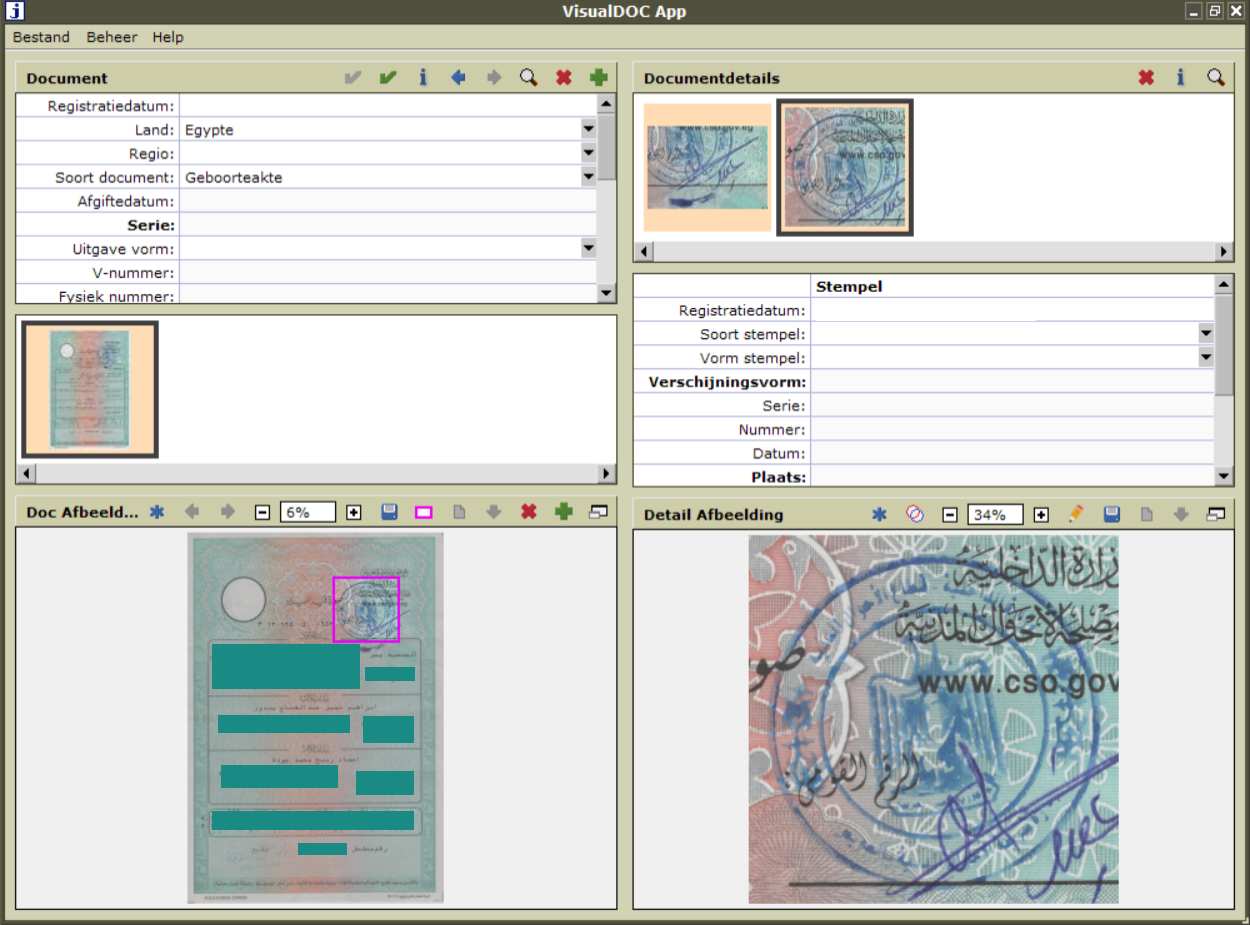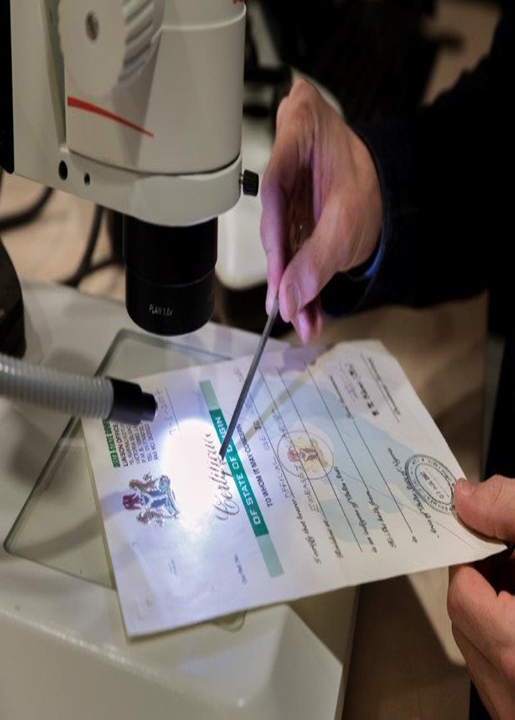VisualDOC

VisualDOC applicatie voor documentonderzoek
VisualDOC is een nieuwe applicatie die is ontwikkeld door Bureau Documenten en TNO.
In VisualDOC wordt Machine-learning ingezet om documentexperts te assisteren in het documentonderzoek.
Op de afbeelding rechts staat een voorbeeld van een geboorteakte uit Egypte. Het land en het type document
wordt gedetecteerd met hulp van AI en wordt in de velden linksboven in het scherm gezet.
Aan de onderkant links is het gescande document te zien met door AI gedetecteerde details. In dit geval is
een stempel en een handtekening gedetecteerd.
In het paneel rechtsboven zijn de gedetecteerde details te selecteren.
Rechtsonder staat het geselecteerde detail. Met hulp van AI kan gezocht worden naar identieke details op
andere documenten.
VisualDOC application for document research
VisualDOC is a new application which is developed by the Document and Identity Office
Netherlands (DION) in collaboration with the Netherlands Organisation for Applied Scientific Research.
In VisualDOC Machine learning is used to assist documentexperts in examining documents.
In the image on the right you see a Birth certificate from Egypt. The country and the type of document is
detected bij AI and is put in the upper left panel of the screen.
On the bottom left is the scanned document with AI detected details. In this case a stamp and a signature
has been detected.
In the upper right panel detected details can be selected.
Finally the bottom right panel displays the selected detail. It is possible to search for identical
details on other documents again using AI.
Document and Identity Office Netherlands

Waarom doet Bureau Documenten onderzoek
In Nederland wonen vreemdelingen uit meer dan 160 verschillende
landen. Zij hebben meestal één of meerdere brondocumenten
overhandigd om te bewijzen dat ze in aanmerking komen voor verblijf, een inschrijving in
de gemeente etc. Zulke brondocumenten als geboorteakten, identiteitskaarten, huwelijksakten en
ongehuwd-verklaringen zijn identificerende documenten die zijn uitgegeven door een buitenlandse
overheidsinstantie. Ook worden documenten die als bewijs zijn overgelegd in een
asielprocedure door Bureau Documenten onderzocht.
Bureau Documenten adviseert overheidsdiensten over de echtheid van een document en/of identiteit en is
gepositioneerd onder de Immigratie- en Naturalisatiedienst van het Ministerie van Justitie en Veiligheid.
Voor dat onderzoek beschikt het Bureau over experts, kennis en specialistische apparatuur en houdt het toezicht
op de ontwikkeling, vervaardiging en verstrekking van vreemdelingendocumenten in Nederland.
Hiermee levert het Bureau een bijdrage aan de nationale veiligheid en aan het tegengaan
van identiteitsfraude. ID-fraude is een vorm van fraude waarbij iemand een valse identiteit aanneemt om daar
voordeel uit te behalen. Daarvoor worden valse of vervalste (bron)documenten gebruikt zoals een geboorte- of huwelijksakte.
In sommige landen is het niet heel ingewikkeld om met een vals brondocument een geldig paspoort te verkrijgen.
Hoe doet Bureau Documenten onderzoek?
Bureau Documenten onderzoekt brondocumenten op drie manieren:
- technisch; hoe is een document geproduceerd? Is een stempel bijvoorbeeld gezet of geprint?
- tactisch; is een document bijvoorbeeld afgegeven in overeenstemming met wat er over de afgifteprocedure bekend is?
- empirisch; komen bijvoorbeeld de stempels die op een document staan overeen met wat documentonderzoekers van Bureau Documenten zelf in het land van herkomst hebben vastgesteld?
Why DION examines documents
Foreigners from more than 160 different countries live in the Netherlands
Usually an applicant for a permit has to produce evidence in form of documents that he/she is eligible
for a residence permit or for registration in the municipality for instance.
Source-documents such as birth certificates, identity cards or marriage-certificates are
identifying documents issued by a foreign government agency. DION examines these identities and
documents for authenticity and also investigates proof that is being submitted in asylum procedures.
DION is advising various government agencies in assessing documents and identities and is organisationwise
an Office in the Immigration and Naturalization Service under the Ministry of Justice and Safety.
With help of advanced equipment and specialized knowledge our experts determine whether the document is
genuine, false or forged. The Bureau is also responsible for regulation of the development, production and
issuance of ID-documents to foreign nationals in the Netherlands.
In this way DION contributes to national security and prevention of identity fraud because often false
or forged source-documents are being used in ID-fraud. For example in some countries it is not very
complicated to obtain a valid passport with a false or forged birth certificate.
How does DION examine doscuments?
DION examines documents in three ways:
- technical; how is a document produced? is a stamp typed or printed for instance?
- tactical; for example has a document been issued in accordance with what is known about the issuance procedure?
- empirical; do the stamps on a document for instance correspond to what DION-researchers have established in the country of origin during factfinding over there?
Machine learning

In VisualDOC wordt machine learning gebruikt om het onderzoek van documenten te versnellen en
de beperkte capaciteit op de juiste zaken te richten. Het overgrote deel van de door Bureau Documenten
onderzochte documenten is in orde, VisualDOC helpt die beperkte groep documenten te detecteren waar
iets mis mee is.
Allereerst gebruiken we een neuraal netwerk om te detecteren wat voor soort document wordt gescand. Uit welk
land komt het, wat is het type document. Daarnaast verwerkt het afbeeldingen, zoekt vergelijkingsmateriaal en
geeft de documentexpert een signaal.
In de afbeelding hieronder is een schema van hoe een neuraal netwerk werkt. Het neurale netwerk heeft veel
voorbeelden nodig om een goed antwoord te kunnen geven. Het is dus belangrijk om het netwerk met de juiste
unbiased data te trainen. Bureau Documenten verzamelt al ruim twee decennia vergelijkings-
en referentiedocumenten -in onze DISCS-software- en beschikt over duizenden documentsoorten van over de
hele wereld. Daardoor zijn we in een unieke positie om VisualDOC (door) te ontwikkelen.
In VisualDOC machine learning is being used to assist in the examination of documents. The vast
majority of documents being examined by DION is genuine and VisualDOC assists in signalling possibly
fraudulent documents by pointing out possible anomalies in document-characteristics.
First of all neural networks are used to detect what kind of document is scanned. What country it is from,
what is the type and so on. Neural networks also proces pictures, search for similar material and produce
a signal to the documentexpert.
In the adjacent picture is a scheme of how a neural netwerk works. It needs plenty of examples to be able
to produce a good signal and it is very important to train the network with sufficient unbiased data. For more
than two decades DION has been collecting documents from all over the world and posesses thousands of different
documents -see our DISCS-software- so we are in a unique position for further developing VisualDOC.
